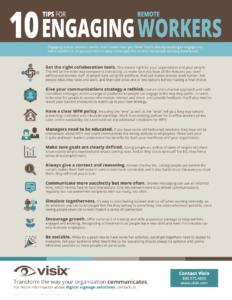Before the COVID-19 pandemic hit, organizations of all types were already making efforts to engage remote employees and move at least some tasks off-site, at least some of the time. Working from home either full- or part-time had been on the rise: the percentage of workers doing things remotely at least once a week had grown 400% since 2010.
Exact numbers vary according to the source, but somewhere around 5-7 million people, or around 3.5% of the workforce, were telecommuting at least half-time by March of 2020, and around 43% worked remotely at least once in a while. All you had to do was look around the office where desks were empty 50-60% of the time on any given day.
Give the People What They Want
However, more than half of workers said that they could work from home sometimes (a Citrix poll in 2019 has that number as high as 62%, with that skyrocketing to 95% for knowledge workers). Owl Labs found that 80% of employees wanted their organizations to figure out a way for them to work from home; 27% even said they’d take a 10-20% pay cut in exchange for the possibility. Offering this became an important part of attracting and retaining talent, improving work-life balance and providing flexibility.
These trends accelerated dramatically after March 2020. According to Nicholas Bloom, an economist at Stanford, an astonishing 42% of the American workforce was currently working from home full-time in June. When you consider that a third of workers lost their jobs, that left just 26% still working on site. Essentially, the U.S. had become a work from home economy in less than a year.
Telecommuting has been key in keeping the economy afloat. Without remote work, lockdowns would have failed to slow the spread of the virus, and the entire economy would have collapsed. People in white collar jobs obviously have an easier time completing their tasks out of the office – no one has yet figured out how to enable a convenience store or fast-food worker to assist people while sitting in a home office.
Having said that, some of those industries that would seem to be remote-work-proof are transforming. Like food, either from restaurants or stores. More people are using delivery or pick up options, and they’re ordering more than when they could only dine in. By the end of the year, at least a third of Americans were using a food delivery option at least once a week, 40% more restaurants started offering a home delivery option and specialized companies like Grubhub saw an average 20% rise in order size. The U.S. is now the second largest food delivery market in the world (China has the number one slot), and many restaurants say they will continue to offer delivery once the pandemic has ended.
If that’s what’s happening with perishables, you can imagine what’s going on in office environments. In almost all sectors, the workplace experience is changing. Even prior to the pandemic in 2019, Owl Labs found that over half of all in-office employees wanted to telecommute at least part-time. Buffer finds that 97.6% of the people surveyed said that they want to work remotely, at least some of the time, for the rest of their working lives. Quite a few people already wanted it, and now that more have tried it, they don’t want to go back to the ways things were before.
As mentioned before, some people say they’d take a pay cut in order to work from home. That’s partly because, when looking at things from a wider perspective, it’s actually in their best interest. Almost a third of people working remotely personally save $5000 a year in costs (commute, lunches, not paying for daycare, etc.) and companies save an average of $10,000 per year for every employee that works at least half-time out of the office. But there’s more to the bottom-line benefits than just dollars and cents.
Happier Employees = Higher Productivity
Over three-quarters of people working remotely say they are more productive than when they were in the office. Contrary to the now-old-fashioned belief that the office is the best place to get work done, Global Workplace Analytics finds that in-office workers are 35-40% less productive than their colleagues working remotely, and workplace distractions cost the business world an astonishing $600 billion a year. 27% of companies say their overall productivity has risen since pandemic-enforced telecommuting started, while 67% say it’s about the same as before.
There’s more job satisfaction among remote employees than those stuck in the office and study after study has shown that happy workers are far more productive. A lot of that is the much-touted work-life balance. People can take breaks when they need to instead of rest periods pre-determined by the job clock. Also, different people are at their peak productivity at different times of the day, and remote workers can adjust their schedules to take advantage of their own individual rhythms. We’re not all morning people, after all. Counter-intuitively, remote employees report fewer distractions, probably because they have total control over their schedules and routines.
And don’t underestimate the boon of not having to commute. Not only is rush hour wearisome, it’s also time consuming. Commute times in America have been increasing steadily since 1980. In 2018, the average person spent 225 hours a year going to and from work. That’s over nine full 24-hour days! Plus, time for gas and car maintenance. That’s a week and a half less time for family or friends or hobbies or even just resting. And this is the average – by 2018, 10% of commuters were travelling 60 minutes or more one-way, and one million more people had a 90-minute one-way commute than in 2010.
All this is going to continue in the future. It’s estimated that 25-30% of the entire workforce will be remote at least twice a week by the end of 2021. Even back at the start of it all, Gartner found that 74% of companies were planning to make at least 5% of their workforce remote once the pandemic was over, with a quarter saying it’ll be at least 10%. And 4% of companies are planning to shift half their workforce to regular or permanent remote work conditions.
This marks one of the greatest shifts in work habits in over a century. The repercussions of this one change, moving to a more remote workforce, will ripple out in new and perhaps unexpected ways.
Economist Nicholas Bloom predicts people will start moving to more suburban or even rural areas. People who don’t especially like living in cities but do so because it makes their commutes easier will be able to migrate to more open spaces and larger homes. People who want to stay in an urban center will find it a little less crowded. When people do commute (since many organizations will most likely end up adopting some sort of hybrid remote/in-office model) they’ll find fewer vehicles on the roads, which means rush hour could end up becoming a thing of the past.
The future job market is likely to be labor-led. Just as things like daycare and flextime were “strange and new” ideas some years ago, they’ve now become a normal and expected part of the employee experience. For decades now, office jobs have been transitioning away from measuring performance against hours and focusing more on KPIs, productivity and job satisfaction. Nowadays, the conversation has simply shifted from “when” to “where”. So don’t think of the remote workforce as something new. It’s been here for a while – it’s just gotten bigger.
Engagement Everywhere
As more people discover that they prefer to work from home, organizations can reap the benefits of this uber-productive workforce by getting on board, getting organized and making sure they can easily extend their engagement efforts to home offices.
We talk about engaging employees a lot because it’s essential to any organization’s success. If you can engage your employees, they’ll stay with you longer, be more satisfied and productive, have fewer accidents and sick days, and add more to both your bottom-line and your culture.
To engage remote employees, you shouldn’t have to start from scratch. Hopefully, you can simply tweak your plans to include people that aren’t always on site. Start by understanding why people want to work from home, the value that those remote workers bring to the table, and what they need from you to succeed. If your focus is on engagement instead of location, both you and your employees will reap the rewards.

